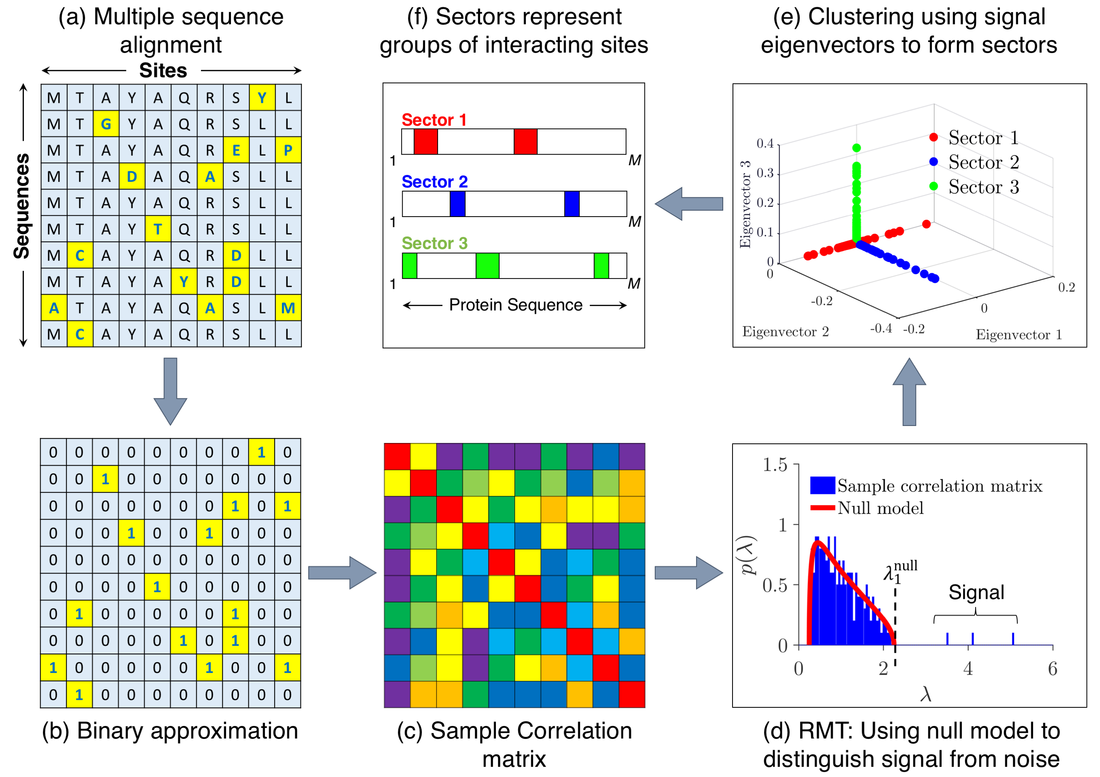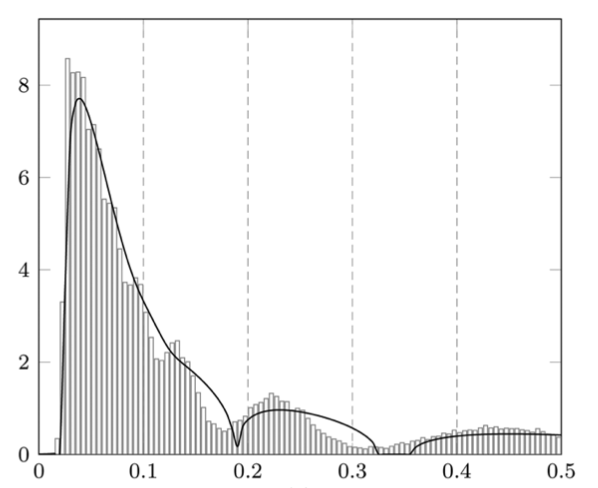Research (Selected Topics)
Computational Biology
Inferring the fundamental co-evolutionary networks employed by viral proteins
Mutational correlation patterns in population-level sequence data have been shown to be informative of viral fitness for certain highly mutable viruses, e.g., Human Immunodeficiency Virus (HIV) and Hepatitis C virus (HCV). Such patterns can be seen as genetic footprints that result from the natural selection of functionally viable strains under diverse evolutionary pressures such as immune responses within individual hosts, modes of transmission at the population level, recombination, reversion, genetic drift, etc.
In this on-going project, using statistical signal processing and machine learning techniques, we study the mutational patterns in the sequence data of multiple viral proteins to identify the inherent co-evolutionary residue networks and their possible association with the structural and functional properties of the proteins. Such an analysis can provide insights that may be harnessed for the purpose of vaccine design.

- S. F. Ahmed, A. A. Quadeer, D. Morales-Jimenez, and M. R. McKay, “Sub-dominant principal components inform new vaccine targets for HIV Gag,” Bioinformatics, 2019.
- A. A. Quadeer, D. Morales-Jimenez, and M. R. McKay, “Co-evolution networks of HIV/HCV are modular with direct association to structure and function“, PLoS Computational Biology, 14(9): e1006409.
- A. A. Quadeer, D. Morales-Jimenez, and M. R. McKay, “A tailored sparse PCA method for finding vaccine targets against Hepatitis C,” Asilomar Conference on Signals, Systems, and Computers, Dec. 2016.
- A. A. Quadeer, R. H. Y. Louie, K. Shekhar, A. K. Chakraborty, I. Hsing, and M. R. McKay, “Statistical linkage analysis of substitutions in patient-derived sequences of genotype 1a Hepatitis C virus nonstructural protein 3 exposes targets for immunogen design,” Journal of Virology, vol. 88, no. 13, pp. 7628-44, 2014.
- A. A. Quadeer, R. H. Y. Louie, K. Shekhar, A. K. Chakraborty, I. Hsing, and M. R. McKay, “Discovering statistical vulnerabilities in highly mutable viruses: A random matrix approach,” IEEE Statistical Signal Processing Workshop, Jun. 2014.
Fitness landscape of viral proteins: Estimation and applications
In this on-going project, we are working to infer the fitness landscape for different viruses, including HIV and polio. The fitness landscape is a functional mapping between an amino acid (or nucleotide) sequence and its corresponding replicative capacity (i.e., the ability of the viral strain to reproduce). Knowledge of a fitness landscape has numerous applications; for example, it can help with guiding vaccine strategies, it can help with understanding the efficacy of current vaccines or drugs, it can inform about mutational pathways used by the virus to confer drug resistance, etc.
Experimentally obtaining the fitness landscape is extremely time-consuming and is generally intractable due to the large size of viral genomes. In this work, we are considering a computational approach to obtain the fitness landscape from sequence data in public databases. This approach is based on a high-dimensional inference procedure—the so-called “maximum-entropy” method of statistical physics—which was previously demonstrated to provide an excellent proxy for the fitness landscape.

- R. H. Y. Louie, K. J. Kaczorowski, J. P. Barton, A. K. Chakraborty, and M. R. McKay, “The fitness landscape of the human immunodeficiency virus envelope protein that is targeted by antibodies“, Proceedings of the National Academy of Sciences of the USA (PNAS), vol. 115, no. 4, pp. E564-E573, Jan. 2018.
- A. A. Quadeer, R. H. Y. Louie, and M. R. McKay, “Identifying immunologically-vulnerable regions of the HCV E2 glycoprotein and broadly neutralizing antibodies that target them,” Nature Communications, vol. 10, no. 1, pp. 2073, 2019.
- A. A. Quadeer, J. P. Barton, A. K. Chakraborty, and M. R. McKay, “Deconvolving mutational patterns of poliovirus outbreaks reveals its intrinsic fitness landscape,” to appear in Nature Communications, 2019.
- A. A. Quadeer, M. R. McKay, J. P. Barton, and Raymond H. Y. Louie, “MPF-BML: A standalone GUI-based package for maximum entropy model inference,” to appear in Bioinformatics, 2019.
A framework for inferring the evolutionary forces driving the evolution of populations from genetic time-series data
Evolution is a never ending process shaped by natural selection, along with various other (stochastic) factors. Observing how a population evolves over time allows us to further our understanding of this fundamental and fascinating process. The theory of Population Genetics, initiated by pioneers Wright and Fisher in the 1920’s (among others), specifies stochastic process models for describing the evolutionary process. Based on this theory, this project investigates the inverse problem of estimating the population genetic forces (genetic drift, selection, mutation and migration) from time-resolved population data. Basically, we are working to develop computationally-efficient approximate Maximum Likelihood parameter estimation techniques which can be applied to infer natural selection in (real world) evolving populations.
- M. S. Sohail^=, R. H. Y. Louie^=, M. R. McKay, and J. P. Barton, ” Resolving genetic linkage reveals patterns of selection in HIV-1 evolution’, accepted in Nature Biotechnology.

Robust Estimation and Financial Engineering
Robust estimation of (large) covariance matrices
The robust estimation of covariance matrices has been a long-standing problem in statistical signal processing. Potential applications are numerous, ranging from wireless communications to financial engineering and biology. In the context of ever larger data sets (both in number of samples and in number of dimensions), traditional robust statistics tools may not apply, or are not well understood.
This project makes use of random matrix theory to study the large-dimensional behavior of a large class of estimators (known as M-estimators) which exhibit resilience to outliers and/or heavy-tailed data. This study allows in turn for a practical analysis of the performance and the robustness of such estimators in the big-data paradigm.

- D. Morales-Jimenez, R. Couillet, and M. R. McKay, “Large Dimensional Analysis of Robust M-Estimators of Covariance with Outliers”, IEEE Transactions on Signal Processing, vol. 63, no. 21, pp. 5784-5797, Nov. 2015.
- N. Auguin, D. Morales-Jimenez, M. R. McKay, and R. Couillet, “Large-Dimensional Behavior of Regularized Maronna’s M-Estimators of Covariance Matrices“, IEEE Transactions on Signal Processing, vol. 66, no. 13, pp. 3529-3542, 2018.
Regularized-robust covariance matrices with application to portfolio design
While robust covariance estimators can exhibit resilience to outliers or impulsive samples, their performance can still be poor when the dimensionality is high, as they become plagued by the “curse of dimensionality”. To deal with this problem, we have considered regularized versions of robust covariance estimators, and developed approaches based on random matrix theory to optimally tune the regularization parameters in a data-driven manner. Specifically, we obtained optimized solutions according to the standard mean-squared-error criteria, and subsequently for the practical problem of large portfolio design in financial engineering. Our solutions demonstrated solid performance on historical financial data, particularly in periods of high market volatility.

- L. Yang, R. Couillet, and M. R. McKay, “A Robust Statistics Approach to Minimum Variance Portfolio Optimization”, IEEE Transactions on Signal Processing, vol. 63, no. 24, pp. 6684-6697, Dec. 2015.
- R. Couillet and M. R. McKay, “Large Dimensional Analysis and Optimization of Robust Shrinkage Covariance Matrix Estimators”, Journal of Multivariate Analysis, vol. 131, pp. 99-120, 2014.
Random Matrices and Multi-Variate Statistics
Many classical multi-variate analysis methods involved linear spectral statistics of the eigenvalues of random matrices, which often have “non central” distributions. The theoretical foundation for such statistics was laid down in Alan James’ landmark 1964 paper, “Distributions of Matrix Variates and Latent Roots Derived from Normal Samples”, in the Annals of Mathematical Statistics. Those results, while foundational, involved hypergeometic functions of matrix arguments, matrix integrals over orthogonal groups, etc., and their scaling properties under large dimensions were not easily established. Considering three scenarios from James’ theory (correlated central Wishart, uncorrelated non-central Wishart, and correlated F matrices), we have derived a new characterization of the linear spectral statistics for a class of so-called “spiked models”, which are important for practical applications. Our results are easily scaled, yielding closed-form formulas under high-dimensional settings. We have also derived eigenvalue distributions for numerous other random matrix models, particularly those arising in contemporary wireless communication systems, such as Hoyt matrices, random matrices with arbitrary variance profiles, non-central Wishart, etc.

- L. Moreno-Pozas, D. Morales-Jimenez, M. R. McKay, and E. Martos-Naya, “Largest Eigenvalue Distribution of Noncircularly-Symmetric Wishart-Type Matrices with Application to Hoyt-Faded MIMO Communications”, to appear in IEEE Transactions on Vehicular Technology.
- N. Auguin, D. Morales-Jimenez, and M. R. McKay, “Exact Statistical Characterization of 2×2 Gram Matrices with Arbitrary Variance Profile”, IEEE Transactions on Vehicular Technology vol. 66, no. 9, pp. 8575 – 8579, 2017.
- D. Passemier, M. R. McKay, and Y. Chen, “Asymptotic Linear Spectral Statistics for Spiked Hermitian Random Matrix Models”, Journal of Statistical Physics, vol. 160, pp. 120-150, 2015.
- D. Passemier, M. R. McKay, and Y. Chen, “Hypergeometric Functions of Matrix Arguments and Linear Statistics of Multi-Spiked Hermitian Matrix Models”, Journal of Multivariate Analysis, vol. 139, pp. 124-146, 2015.
- Y. Chen, N. S. Haq, and M. R. McKay, “Random Matrix Models, Double-Time Painleve Equations, and Wireless Relaying”, Physical Review B, vol. 54, pp. 063606.1-063506.55, 2013.
- P. Dharmawansa, M. R. McKay, and Y. Chen, “Analysis of the Distributions of Demmel and Related Condition Numbers”, SIAM Journal on Matrix Analysis and Applications, vol. 34, no. 1, pp. 257-279, 2013.
- C. Zhong, M. R. McKay, T. Ratnarajah, and K.-K. Wong, “Distribution of the Demmel Condition Number of Wishart Matrices”, IEEE Transactions on Communications, vol. 59, no. 5, pp. 1309-1320, May 2011.
- P. Dharmawansa and M. R. McKay, “Extreme Eigenvalue Distributions of Correlated Non-Central Wishart and Gamma-Wishart Random Matrices”, Journal of Multivariate Analysis, vol. 102, pp. 847-868, Apr. 2011.
- L. Wei, M. R. McKay, and O. Tirkkonen, “Exact Demmel Condition Number Distribution of Complex Wishart Matrices via the Mellin Transform”, IEEE Communications Letters, vol. 15, no. 2, pp. 175-177, Feb. 2011.
- M. Matthaiou, M. R. McKay, P. J. Smith, and J. A. Nossek, “On the Condition Number Distribution of Complex Wishart Matrices”, IEEE Transactions on Communications, vol. 58, no. 6, pp. 1705-1717, June 2010.
- P. Dharmawansa and M. R. McKay, “Diagonal Distribution of a Complex Noncentral Wishart Matrix: A New Trivariate Non-Central Chi-Squared Density”, Journal of Multivariate Analysis, vol. 100, issue 4, pp. 561-580, Apr. 2009.
Signal Processing for Multi-Antenna and 5G Wireless Communications
Ever-increasing data rate and connectivity requirements are posing unprecedented challenges for future 5G wireless communication systems, calling for the development of new advanced signal processing methodologies. A critical issue is to facilitate reliable and high-throughput communications in large-scale networks, which are plagued by hostile channel conditions and multi-user interference. We have made a number of contributions which partially aim to address these challenges. For example, we have designed novel optimized power control strategies for massive multi-cell MIMO networks, efficient detection methods for cognitive radio networks, intelligent transmission techniques in multi-user MIMO systems, etc.

- L. Yang, M. R. McKay, and R. Couillet, “High-Dimensional MVDR Beamforming: Optimized Solutions based on Spiked Random Matrix Models”, to appear in IEEE Transactions on Signal Processing.
- Y. Wu, R. H. Y. Louie, and M. R. McKay, “Asymptotic Outage Probability of MIMO-MRC Systems in Double-Correlated Rician Environments”, IEEE Transactions on Wireless Communications, vol. 15, no. 1, pp. 367-376, Jan. 2016.
- Q. Zhang, S. Jin, M. R. McKay, D. Morales-Jimenez, and H. Zhu, “Power Allocation Schemes for Multicell Massive MIMO Systems”, IEEE Transactions on Wireless Communications, vol. 14, no. 11, pp. 5941-5955, Nov. 2015.
- D. Morales, R. Louie, M. R. McKay, and Y. Chen, “Multiple-Antenna Signal Detection in Cognitive Radio Networks with Multiple Primary User Signals”, IEEE Transactions on Signal Processing, vol. 63, no. 18, pp. 4925-4939, Sept. 2015.
- L. Sun, M. R. McKay, and M. Lei, “Tomlinson-Harashima Precoding for Multiuser MIMO Systems with Quantized CSI Feedback and User Scheduling”, IEEE Transactions on Signal Processing, vol. 62, no. 16, pp. 4077-4090, Aug. 2014.
- Y. Wu, S. Jin, X. Gao, C. Xiao, and M. R. McKay, “MIMO Multichannel Beamforming in Rayleigh-Product Channels with Arbitrary-Power Co-Channel Interference and Noise”, IEEE Transactions on Wireless Communications, vol. 11, no. 10, pp. 3677-3691, Oct. 2012.
- Q. Wang, P. Fan, M. R. McKay, and K. B. Letaief, “On the Position Selection of Relays in Diamond Relay Networks”, IEEE Transactions on Communications, vol. 59, no. 9, pp. 2515-2527, Sept. 2011.
- H. Zhang, M. R. McKay, S. Jin, X. Zhang, and D. Yang, “High-SNR Performance of MIMO Multi-Channel Beamforming in Double-Scattering Channels”, IEEE Transactions on Communications, vol. 59, no. 6, pp. 1621-1631, June 2011.
- L. Sun and M. R. McKay, “Eigen-Based Transceivers for the MIMO Broadcast Channel with Semi-Orthogonal User Selection”, IEEE Transactions on Signal Processing, vol. 58, no. 10, pp. 5246-5261, Oct. 2010.
- W. Wang, S. Jin, X. Gao, K.-K. Wong, and M. R. McKay, “Power Allocation Strategies for Distributed Space-Time Codes in Two-Way Relay Networks”, IEEE Transactions on Signal Processing, vol. 58, no. 10, pp. 5331-5339, Oct. 2010.
- C. B. Chae, A. Forenza, R. W. Heath Jr., M. R. McKay, and I. B. Collings, “Adaptive MIMO Transmission Techniques for Broadband Wireless Communication Systems”, IEEE Communications Magazine, pp. 112-118, May 2010.
- C. Zhong, S. Jin, K. K. Wong, and M. R. McKay, “Outage Analysis for Optimal Beamforming MIMO Systems in Multi-Keyhole Channels”, IEEE Transactions on Signal Processing, vol. 58, no. 3, part 1, pp 1451-1456, Mar. 2010.
- L. Sun, E. Au, and M. R. McKay, “Adaptive MIMO Multichannel Beamforming with Co-Channel Interference and Noise: Algorithm and Performance Analysis”, IEEE Transactions on Vehicular Technology, vol. 58, no. 8, pp. 4368-4379, Oct. 2009.
- X. Gao, B. Jiang, X. Li, A. B. Gershman, and M. R. McKay, “Statistical Eigenmode Transmission over Jointly-Correlated MIMO Channels”, IEEE Transactions on Information Theory, vol. 55, no. 8, pp. 3735-3750, Aug. 2009.
- R. H. Y. Louie, M. R. McKay, and I. B. Collings, “New Performance Results for Multiuser Optimum Combining in the Presence of Rician Fading”, IEEE Transactions on Communications, vol. 57, no. 8, pp. 2348-2359, Aug. 2009.
- L. Sun, M. R. McKay, and S. Jin, “Analytical Performance of MIMO Multichannel Beamforming in the Presence of Unequal Power Cochannel Interference and Noise”, IEEE Transactions on Signal Processing, vol. 57, no. 7, pp. 2721-2735, July 2009. Received the 2010 Young Author Best Paper Award by IEEE Signal Processing Society.
- M. R. McKay, A. Zanella, I. B. Collings, and M. Chiani, “Error Probability and SINR Analysis of Optimum Combining in Rician Fading”, IEEE Transactions on Communications, vol. 57, no. 3, pp. 676-687, Mar. 2009.
- S. Jin, M. R. McKay, X. Gao, and I. B. Collings, “MIMO Multichannel Beamforming: SER and Outage Using New Eigenvalue Distributions of Complex Noncentral Wishart Matrices”, IEEE Transactions on Communications, vol. 56, no. 3, pp. 424-434, Mar. 2008. Received the 2011 Stephen O. Rice Award by IEEE Communication Society.
- E. K. S. Au, S. Jin, M. R. McKay, W. H. Mow, X. Gao, and I. B. Collings, “Analytical Performance of MIMO-SVD Systems in Ricean Fading Channels with Channel Estimation Error and Feedback Delay”, IEEE Transactions on Wireless Communications, vol. 7, no. 4, pp. 1315-1325, Apr. 2008.
- M. R. McKay, I. B. Collings, A. Forenza, and R. W. Heath Jr., “Beamforming/Multiplexing Switching for Coded-MIMO in Spatially-Correlated Channels Based on Closed-Form BER Approximations”, IEEE Transactions on Vehicular Technology, vol. 56, pp. 2555-2567, Sept. 2007.
- M. R. McKay, A. J. Grant, and I. B. Collings, “Performance Analysis of MIMO-MRC in Double-Correlated Rayleigh Environments”, IEEE Transactions on Communications, vol. 55, no. 3, pp. 497-507, Mar. 2007.
- M. R. McKay and I. B. Collings, “Error Performance of MIMO-BICM with Zero-Forcing Receivers in Spatially-Correlated Rayleigh Channels”, IEEE Transactions on Wireless Communications, vol. 6, no. 3, pp. 787-792, Mar. 2007.
- S. Jin, M. R. McKay, X. Gao, and I. B. Collings, “Asymptotic SER and Outage Probability of MIMO MRC in Correlated Fading”, IEEE Signal Processing Letters, vol. 14, no. 1, pp. 9-12, Jan. 2007.
Stochastic Geometry and Wireless Ad-Hoc Networks
Multi-hop wireless ad-hoc networks are peer-to-peer networks in which nodes communicate with one another without the aid of a fixed infrastructure. Such networks have become an increasingly hot topic in recent years, due to their application in a wide range of scenarios, including emergency, military, sensor, and community mesh networks. In this project, we have studied the information theoretic capacity of wireless ad-hoc networks, and developed novel signal processing strategies for their deployment in practice. The key to obtaining these results was to employ powerful techniques from the fascinating mathematical field of stochastic geometry.

- Y. Wu, R. H. Y. Louie, and M. R. McKay, “Analysis and Design of Wireless Ad Hoc Networks with Channel Estimation Errors”, IEEE Transactions on Signal Processing, vol. 61, no. 6, pp. 1447-1459, Mar. 2013.
- Y. Wu, R. H. Y. Louie, M. R. McKay, and I. B. Collings, “Generalized Framework for the Analysis of Linear MIMO Transmission Schemes in Decentralized Wireless Ad Hoc Networks”, IEEE Transactions on Wireless Communications, vol. 11, no. 8, pp. 2815-2827, Aug. 2012.
- R. H. Y. Louie, M. R. McKay, and I. B. Collings, “Open-Loop Spatial Multiplexing and Diversity Communications in Ad Hoc Networks”, IEEE Transactions on Information Theory, vol. 57, no. 1, pp. 317-344, Jan. 2011.
Physical Layer Security
With the explosive rise in popularity of wireless communications, data security is becoming ever more critical. Both the magnitude and sensitivity of wireless data are increasing dramatically, further exemplifying the security issue. We have explored a promising security paradigm known as “physical-layer security”, which provides a new way of designing wireless communication systems. The key idea is to intelligently design the physical layer signals in order to ensure robustness against security attacks, rather than the current approach of relying on higher-layer protocols. Physical-layer security methods, rooted in information theory, are promising as they can complement and significantly strengthen existing security approaches. Our main contributions have been to develop multi-antenna beamforming methods which are optimized to provide physical-layer security, while sustaining adequate communication performance.

- G. Gomez, F. J. Lopez-Martinez, D. Morales-Jimenez, and M. R. McKay, “On the Equivalence between Interference and Eavesdropping in Wireless Communications”, IEEE Transactions on Vehicular Technology, vol. 64, no. 12, pp. 5935-5940, Dec. 2015.
- X. Zhang, M. R. McKay, X. Zhou, and R. W. Heath Jr., “Artificial-Noise-Aided Secure Multi-Antenna Transmission with Limited Feedback”, IEEE Transactions on Wireless Communications, vol. 14, no. 5, pp. 2742-2754, May 2015.
- X. Zhang, X. Zhou, and M. R. McKay, “Enhancing Secrecy with Multi-Antenna Transmission in Wireless Ad Hoc Networks”, IEEE Transactions on Information Forensics and Security, vol. 8, no. 11, pp. 1802-1814, Nov. 2013.
- X. Zhang, X. Zhou, and M. R. McKay, “On the Design of Artificial-Noise-Aided Secure Multi-Antenna Transmission in Slow Fading Channels”, IEEE Transactions on Vehicular Technology, vol. 62, no. 5, pp. 2170-2181, June 2013.
- X. Zhou, M. R. McKay, B. Maham, and A. Hjørungnes, “Rethinking the Secrecy Outage Formulation: A Secure Transmission Design Approach”, IEEE Communications Letters, vol. 15, no. 3, pp. 302-304, Mar. 2011.
- X. Zhou and M. R. McKay, “Secure Transmission with Artificial Noise over Fading Channels: Achievable Rate and Optimal Power Allocation”, IEEE Transactions on Vehicular Technology, vol. 59, no. 8, pp. 3831-3842, Oct. 2010.
Information Theory of MIMO Wireless Channels
MIMO (multi-input multi-output) antenna systems have become a core technology in modern wireless communication systems, since they offer (in theory) linear capacity improvements, without necessitating additional power or bandwidth. While the average or ergodic capacity has been well understood for nearly two decades, the outage capacity—a relevant performance measure in slow fading channels—is not. This requires characterization of the distribution of the mutual information between transmit and receive antennas, which is a very difficult problem. To address this, we have introduced new methodologies from statistical physics (in fact, going back to seminal work of Freeman Dyson on nuclear physics), which are well suited to the outage capacity problem. By using the so-called “Coulomb Fluid” approach as well as tools from the theory of orthogonal polynomials, we have discovered an exact characterization of the moment generating function of the mutual information distribution, involving Painleve differential equations. This has enabled the computation of the cumulants of the distribution to any order, which allows for a fine characterization of the distribution of the tail (the region of practical interest for the outage capacity). Results have been developed for the canonical case of uncorrelated Rayleigh fading channels, and also for relay channels. We have also derived capacity results for various MIMO systems, and under different stochastic fading models.

- Y. Wu, S. Jin, X. Gao, C. Xiao, M. R. McKay, and K. K. Wong, “On the Fading MIMO Broadcast Channel: Rate Region and Characterization with Channel Distribution Information”, IEEE Transactions on Signal Processing, vol. 62, no. 17, pp. 4451-4466, Sept. 2014.
- L. Shang, M. R. McKay, and Y. Chen, “On the Distribution of MIMO Mutual Information: An In-Depth Painleve Based Characterization”, IEEE Transactions on Information Theory, vol. 59, no. 9, pp. 5271-5296, Sept. 2013.
- M. Matthaiou, C. Zhong, M. R. McKay, and T. Ratnarajah, “Sum Rate Analysis of ZF Receivers in Distributed MIMO Systems”, IEEE Journal on Selected Areas in Communications, vol. 31, no. 2, pp. 180-191, Feb. 2013.
- Y. Chen and M. R. McKay, “Coulomb Fluid, Painleve Transcendents, and the Information Theory of MIMO Systems”, IEEE Transactions on Information Theory, vol. 58, no. 7, pp. 4594-4634, July 2012.
- Y. Liu, P. Dharmawansa, M. R. McKay, and K. B. Letaief, “Finite-SNR Diversity-Multiplexing Trade-off of Dual Hop Multiple-Relay Channels”, IEEE Transactions on Communications, vol. 50, no. 5, pp. 1451-1463, May 2012.
- L. Sun, P. Li, M. R. McKay, and R. D. Murch, “Capacity of MIMO Systems with Mutual Coupling: Transmitter Optimization with Dual Power Constraints”, IEEE Transactions on Signal Processing, vol. 60, no. 2, pp. 848-861, Feb. 2012.
- P. Dharmawansa, M. R. McKay, R. K. Mallik, and K. B. Letaief, “Ergodic Capacity and Beamforming Optimality for MISO Relaying with Statistical CSI”, IEEE Transactions on Communications, vol. 59, no. 8, pp. 2119-2131, Aug. 2011.
- C. Zhong, S. Jin, K. K. Wong, and M. R. McKay, “Ergodic Mutual Information Analysis for Multi-Keyhole MIMO Channels”, IEEE Transactions on Wireless Communications, vol. 10, no. 6, pp. 1754-1763, June 2011.
- P. Dharmawansa, M. R. McKay, and R. K. Mallik, “Analytical Performance of Amplify-and-Forward MIMO Relaying with Orthogonal Space-Time Block Codes”, IEEE Transactions on Communications, vol. 58, no. 7, pp. 2147-2158, July 2010.
- S. Jin, M. R. McKay, K.-K. Wong, and X. Li, “Low SNR Capacity of Multiple-Antenna Systems with Statistical Channel State Information”, IEEE Transactions on Vehicular Technology, vol. 59, no. 6, pp. 2874-2884, July 2010.
- S. Jin, M. R. McKay, C. Zhong, and K.-K. Wong, “Ergodic Capacity Analysis of Amplify-and-Forward MIMO Dual-Hop Systems”, IEEE Transactions on Information Theory, vol. 56, no. 5, pp. 2204-2224, May 2010.
- X. Li, S. Jin, X. Gao, and M. R. McKay, “Capacity Bounds and Low Complexity Transceiver Design for Double-Scattering MIMO Multiple Access Channels”, IEEE Transactions on Signal Processing, vol. 58, no. 5, pp. 2809-2822, May 2010.
- X. Li, S. Jin, M. R. McKay, X. Gao, and K.-K. Wong, “Capacity of MIMO-MAC with Transmit Channel Knowledge in the Low SNR Regime”, IEEE Transactions on Wireless Communications, vol. 9, no. 3, pp. 926-931, Mar. 2010.
- M. R. McKay, I. B. Collings, and A. M. Tulino, “Achievable Sum Rate of MIMO MMSE Receivers: A General Analytic Framework”, IEEE Transactions on Information Theory, vol. 56, no. 1, pp 396-410, Jan. 2010.
- R. H. Y. Louie, M. R. McKay, and I. B. Collings, “Sum Capacity of MIMO Multiuser Scheduling with Linear Receivers”, IEEE Transactions on Communications, vol. 57, no. 11, pp. 3500-3510, Nov. 2009.
- S. Jin, M. R. McKay, K. K. Wong, and X. Gao, “Transmit Beamforming in Rayleigh Product MIMO Channels: Capacity and Performance Analysis”, IEEE Transactions on Signal Processing, vol. 56, no. 10, pp 5204-5221, Oct. 2008.
- M. R. McKay, P. J. Smith, H. A. Suraweera, and I. B. Collings, “On the Capacity Distribution of OFDM-Based Spatial Multiplexing: Exact Variance and Outage Approximation”, IEEE Transactions on Information Theory, vol. 54, no. 7, pp. 3260-3278, July 2008.
- R. H. Y. Louie, M. R. McKay, and I. B. Collings, “Impact of Correlation on the Capacity of Multiple Access and Broadcast Channels with MIMO-MRC”, IEEE Transactions on Wireless Communications, vol. 7, no. 6, pp. 2397-2407, June 2008.
- A. Forenza, M. R. McKay, A. Pandharipande, R. W. Heath Jr., I. B. Collings, “Adaptive MIMO Transmission for Exploiting the Capacity of Spatially Correlated Channels”, IEEE Transactions on Vehicular Technology, vol. 56, no. 2, pp. 619-630, Mar. 2007.
- M. R. McKay and I. B. Collings, “On the Capacity of Frequency-Flat and Frequency-Selective Rician MIMO Channels with Single-Ended Correlation”, IEEE Transactions on Wireless Communications, vol. 5, no. 8, pp. 2038-2043, Aug. 2006.
- M. R. McKay and I. B. Collings, “Improved General Lower Bound for Spatially-Correlated Rician MIMO Capacity”, IEEE Communication Letters, pp. 162-164, Mar. 2006.
- M. R. McKay and I. B. Collings, “General Capacity Bounds for Spatially Correlated Rician MIMO Channels”, IEEE Transactions on Information Theory, vol. 51, no. 9, pp. 3121-3145, Sep. 2005.
- M. R. McKay and I. B. Collings, “Capacity and Performance of MIMO-BICM with Zero-Forcing Receivers”, IEEE Transactions on Communications, vol. 3, no. 1, pp. 74-83, Jan. 2005.
